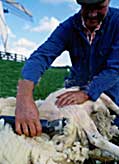|  Over
the course of some 200 years the Merino sheep has
formed the very backbone of South Africa's agricultural
industry. Over
the course of some 200 years the Merino sheep has
formed the very backbone of South Africa's agricultural
industry.
Fat-tailed sheep were first introduced
into South Africa by European settlers who obtained
initial breeding stock from the Hottentots through
a bartering arrangement. In following year they
imported more sheep from Holland and Bengal.
In the early 1700s the Governor of
South Africa tried to create interest with the South
African farmers in the production of fine wool.
 Merino sheep were gradually introduced into South
Africa in the early 1700's but no real progress
was made in their establishment until 1785 when
Colonel Gordon imported Merinos from Spain of the
Escurial stock. These appear to have been bred with
native sheep.
Merino sheep were gradually introduced into South
Africa in the early 1700's but no real progress
was made in their establishment until 1785 when
Colonel Gordon imported Merinos from Spain of the
Escurial stock. These appear to have been bred with
native sheep.
On his death a dispute arose between
his widow and the Dutch government over ownership
of the flock which led to it being sold to Captain
Waterhouse who took them to Australia. Captain Waterhouse
and Captain Kent had been sent to South Africa from
Australia by John Macarthur with instructions to
buy any fine woolled sheep available. They purchased
26 sheep with Macarthur receiving three rams and
five ewes.
 In 1789 the King of
Spain sent the Dutch government two Merino rams
and four ewes as a gift, but the sheep were sent
to the Cape as it was thought the climate would
be more suitable for them.
In 1789 the King of
Spain sent the Dutch government two Merino rams
and four ewes as a gift, but the sheep were sent
to the Cape as it was thought the climate would
be more suitable for them.
In 1818 the first pure-bred Merino
breeding stud was established by Lord Charles Somerset
at the government farm at Marmesbury. The aim was
to help distribute rams among the farming community.
Cape wool was first exported in 1980
but it was not until the middle of the century,
after many experiments with different strains including
the Spanish Merino, the Saxon, the Rambouillet,
plus some of the English breeds that the definite
South African type of Merino was established
By 1830 the farming of the Merino
sheep was well established in the Western and Southwestern
parts of the Cape, while the next move for expansion
and growth was to go eastward. With the 1820 settlers
playing a big part in this.
In 1834 the Great Trek started and
the great flocks of sheep headed eastwards. Within
only a few years the Merino sheep covered the country.
 By 1940 wool had become
South Africa's most important export.
By 1940 wool had become
South Africa's most important export.
By 1846 there were over 3 million
sheep in South Africa, of which half were Merinos,
while other types such as the Saxony, the Rambouillet
and the Vermont were not considered suitable for
the South African conditions.
By 1900, with the Australian merino
sheep being considered the most suitable type for
the climate, South Africa was importing them at
a constant pace, before the 1929 Commonwealth Government
embargo on the export of Merinos.
About half of the total sheep population in South
Africa lives in the semi-arid area which covers
85% of the country.
 Today the South African
is one of the major wool producing countries of
the world producing high quality, apparel wools
which are exported around the world.
Today the South African
is one of the major wool producing countries of
the world producing high quality, apparel wools
which are exported around the world.
|